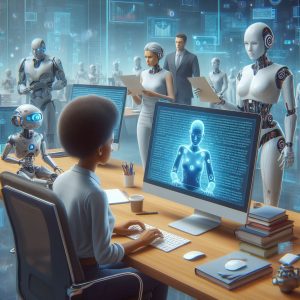Costume designers have long been the creative force behind the visual aesthetics of any performance or production. From the intricate costumes of historical dramas to the futuristic outfits of science fiction movies, costume designers bring characters to life through their meticulous attention to detail and artistic flair. However, the advent of artificial intelligence (AI) is introducing a new dimension to the art of costume design, creating a unique fusion of technology and creativity.
AI’s Role in Costume Design
AI has the potential to revolutionize the costume design process in several ways:
1. Design Assistance: AI algorithms can analyze vast databases of historical costumes, fashion trends, and cultural influences to generate unique and innovative design concepts. This assistance allows costume designers to explore a wider range of possibilities and come up with ideas they might not have considered otherwise.
2. Fabric and Material Selection: AI can analyze different fabrics and materials to determine their suitability for specific characters or scenes. It can consider factors such as texture, drape, and durability to help designers select the most appropriate materials for their designs.
3. Virtual Try-Ons: AI-powered virtual try-on technology allows designers to see how a costume will look on an actor or model without physically creating the garment. This saves time and resources, enabling designers to refine their designs and make adjustments before committing to production.
4. Color and Pattern Matching: AI can analyze color palettes and patterns to ensure that costumes are visually cohesive and harmonious. This is particularly useful for period pieces or productions where color accuracy is crucial.
5. Historical Research: AI can analyze historical documents, paintings, and artifacts to extract accurate details about clothing and accessories worn in different eras. This knowledge can be invaluable for costume designers working on historical productions, ensuring authenticity and attention to detail.
Benefits of AI in Costume Design
The integration of AI into costume design offers several benefits:
1. Efficiency: AI can automate repetitive tasks such as research and fabric selection, freeing up costume designers to focus on more creative aspects of their work.
2. Accuracy: AI can help costume designers achieve a high level of historical accuracy by analyzing vast databases of reference material.
3. Innovation: AI can generate unique and innovative design concepts that push the boundaries of creativity and help costume designers stand out.
4. Collaboration: AI can facilitate collaboration between costume designers, actors, and directors by providing a shared digital platform for sharing ideas and feedback.
Challenges in AI-Assisted Costume Design
While AI holds great promise for costume design, there are also challenges to consider:
1. Ethical Concerns: The use of AI in costume design raises ethical questions about the role of human creativity and the potential for AI to replace human designers.
2. Technical Limitations: AI systems are still limited in their ability to understand and interpret human aesthetics and cultural nuances. This can lead to designs that lack emotional depth or fail to capture the essence of a character.
3. Over-Reliance on AI: Costume designers need to strike a balance between relying on AI for assistance and maintaining their own creative vision. Over-reliance on AI can result in designs that lack personality and originality.
4. Data Bias: AI algorithms are trained on data, and if the data is biased, the algorithm’s output will also be biased. This can lead to inaccurate or culturally insensitive costume designs.
Conclusion
The fusion of AI and creativity in costume design is a transformative force that is reshaping the industry. While AI cannot replace the artistry and vision of human costume designers, it can provide valuable assistance and enhance the creative process. As AI technology continues to evolve, it is crucial for costume designers to embrace this new tool while preserving their unique creative perspectives. Through this collaboration between human and machine, the future of costume design promises to be both innovative and captivating.



